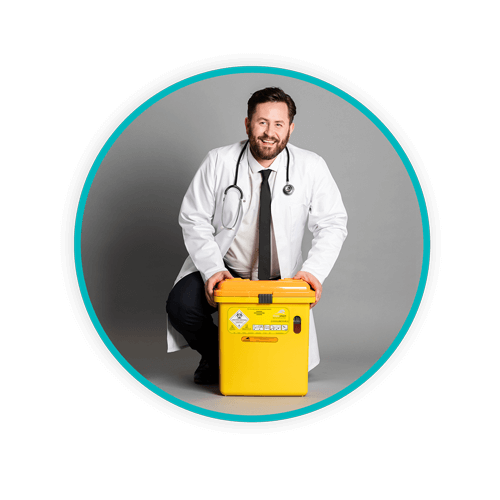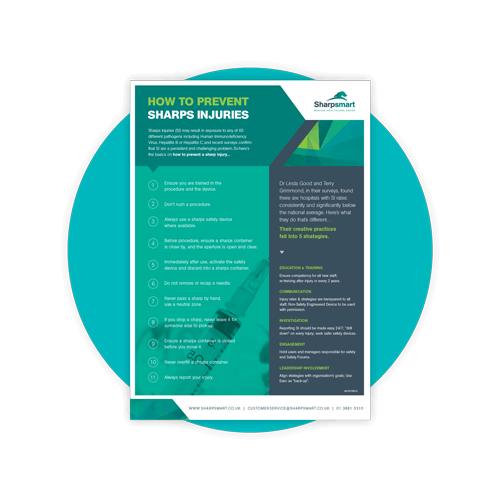Expert Tips for Reducing Needlestick Injuries within Healthcare Settings

How many healthcare workers do you know that have suffered a needlestick injury? Perhaps you’ve suffered one yourself. Or more than one.
Sharpsmart has been reducing needlestick injuries (NSIs) within healthcare settings for decades and it’s something we take seriously on our mission towards making healthcare safer.
Read on to discover some helpful tips from our sharps safety experts for reducing needlestick injuries within healthcare settings.
OUR EXPERTS AND THEIR TOPICS:
1 / Mary Kenyon: Taking Ownership and Accountability
2 / Ben Martyn: Procedural Preparation Is Key
3 / Sergio Hervas: Reporting NSIs Is Crucial
4 / From Sharpsmart: Resources for Reducing Needlestick Injuries
5 / Supporting You with Needlestick Injury Reduction
Mary Kenyon: Taking Ownership and Accountability

“By taking ownership and accountability of the sharps waste you’re producing, you’ll be protecting your colleagues, patients and visitors.”
It’s essential for every healthcare worker to be accountable for the sharps waste you produce. For example, if you fill a sharps bin it’s your responsibility to close it down, regardless of your position. There’s been an industry-wide assumption for many years that closing down sharps containers is a housekeeper’s job. Firstly, that’s not the case and if it was, what happens when they’re not at work?
Failing to close down a full sharps container and replace it puts fellow staff, patients and visitors at risk of injury.
What do you do when you see an overfilled sharps container?
Of course, whoever filled it should have closed it down and replaced but if that hasn’t been done and now you’ve found it, it’s down to you to ensure it’s replaced.
Another element of sharps waste accountability is ensuring you take a sharps container with you to the point of procedure. This is best practice regardless of which types of containers you use and whether they’re single-use or reusable sharps containers.
In fact, if everyone took a sharps container with them to the point of procedure, there would be significantly fewer NSIs.
With your sharps container at the point of procedure and within arm’s reach, you’ll be able to dispose of the waste immediately after use and it doesn’t have to touch a tray or any other surface before being disposed of safely.
A final tip on the subject of disposal and something I’ve seen several times is needles being de-notched and the syringe bodies being disposed of in bagged waste streams. This one is a big no-no and a huge risk factor for injury. You don’t want to be handling needles for longer than you have to and all the more so if the syringe contains pharmaceuticals.
Ben Martyn: Procedural Preparation Is Key

“There’s no such thing as a good needlestick injury.”
I’d say it all comes down to procedural preparation.
Ensure staff are trained in the procedures they’re carrying out and the equipment and safety devices involved, including both the needles and the sharps containers.
On the subject of sharps containers, you’ll need one that isn’t full and when preparing your workspace for the procedure, you’ll want your container within the ‘golden one metre’ from the point of procedure.
The safest procedures closely resemble these steps:
- Put the needle in the patient
- Remove the needle from the patient
- Dispose of the needle immediately
And all without moving your feet.
Once the needle has been removed from the patient it shouldn’t be put down anywhere for any amount of time, just disposed of straight away.
There’s been a recognisable rise in clinical staff re-sheathing/re-capping needles as needles that have been designed with safety catches and covers seem to have instilled a false sense of security. Being a safety device doesn’t make them safe to walk around with, accidents can and do still happen.
Subsequently, this results in clinical staff not taking a sharps container to the procedure area and either carrying dirty needles around by hand or in trays to another part of the department for disposal, putting themselves and other staff and visitors at risk.
Sergio Hervas: Reporting NSIs Is Crucial

“Sustainability is top of the agenda, but we can’t afford to forget about needlestick injuries.”
I’ll start by saying that each department works slightly differently and some are more prone to needlestick injuries than others.
A common theme amongst higher needlestick injury rates tends to be during the weekends when departments such as A&E are busier and as a result, more chaotic. This can often spill over into the beginning of the week, resulting in NSIs sustained by clinical staff using overfilled single-use sharps containers that haven’t been replaced during the weekend. These full containers are often left in place due to staff shortages or a general lack of awareness.
It’s also an industry-wide concern that many healthcare workers aren’t reporting needlestick injuries. Without NSIs being reported, the crucial changes that can help reduce them won’t be made.
Some Trusts have great reporting systems but staff can sometimes feel held back by embarrassment or fear of retaliation, discrimination, or stigmatisation.
Removing the stigma around reporting needlestick injuries and introducing standardised reporting tools and programmes would change the UK healthcare system for the better, and reduce needlestick injuries as a result.
To do this, we need a renewed focus on needlestick injury reduction and its importance. With the push for Net Zero, the updated HTM 07-01, and the NHS Clinical Waste Strategy, sustainability is top of the agenda, but we can’t afford to forget about needlestick injuries – some solutions help both safety and sustainability.
From Sharpsmart: Resources for Reducing Needlestick Injuries
“Sharpsmart has long recognised that a clinical environment requires a clinical solution and that’s why we’ve always done far more than provide a container and waste pickup service. For us and our mission to make healthcare safer, real change starts within the four walls of your facility.”
Every needlestick injury comes with a cost, both financially and emotionally. We’re determined to continue making healthcare safer and reducing needlestick injuries.
The beginning of reducing needlestick injuries is to know what sharps waste is and how to safely dispose of needles. But that is just the beginning. It’s also crucial to understand how to deal with a needlestick injury in case it does happen.
Most of all, you want to know how to prevent needlestick injuries from occurring in the first place.
Over the years at Sharpsmart, we’ve put together many resources for preventing needlestick injuries, such as our “How to Prevent Sharps Injuries” poster which is available as a free download and lists 11 helpful tips for preventing needlestick injuries:
1. Ensure you’re trained in the procedure and the device.
2. Don’t rush a procedure.
3. Always use a sharps safety device where available.
4. Before procedure, ensure a sharps container is close by, and the aperture is open and clear.
5. Immediately after use, activate the safety device and discard into a sharps container.
6. Do not remove or recap a needle.
7. Never pass a sharp by hand, use a neutral zone.
8. If you drop a sharp, never leave it for someone else to pick up.
9. Ensure a sharps container is closed before you move it.
10. Never overfill a sharps container. Never.
11. Always report your injury.
Download Poster
We hope you’ve found the expert tips and resources in the blog helpful, please share this information with anyone you feel may benefit. Together, we can continue making healthcare safer!
 Supporting You with Needlestick Injury Reduction
Supporting You with Needlestick Injury Reduction
Sharpsmart has been reducing needlestick injuries in the UK for over 20 years and we set the ISO standard for reusable sharps containers. Our safety-engineered devices have been proven to reduce sharps injuries by up to 87%.
Our inside-the-four-walls approach and optimised waste management solutions ensure that containers are placed in the right places and that staff are educated and trained on best practices with point-of-use disposal.
If you’d like support or guidance on a fully managed sharps waste programme proven to reduce needlestick injuries, please don’t hesitate to get in touch.
Let's Talk!
Your time is valuable, and we don’t want to play hard to get. You can either phone us directly on the details listed on our contact page, or feel free to fill out this short form and one of our team members will get back to you as quickly as possible.

